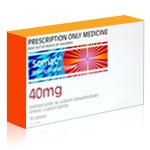Everything You Need to Know About Duodenal Ulcers


A duodenal ulcer is a type of peptic ulcer that forms in the duodenum, the first part of the small intestine just beyond the stomach. It is a common condition that affects many people globally and can cause considerable discomfort if left untreated. This article will explore the key aspects of duodenal ulcers, including their signs and symptoms, the differences between duodenal and gastric ulcers, diagnosis methods, healing processes, and the important role of Protonix in treatment.
What Are the Cardinal Signs of a Duodenal Ulcer?
The symptoms of a duodenal ulcer are often noticeable but may be confused with other digestive conditions. The cardinal signs include a burning pain or discomfort in the upper abdomen, usually occurring 1-3 hours after eating, or in the middle of the night. The pain tends to be relieved by eating or by taking antacids, which is a key distinguishing factor of duodenal ulcers.
Other common symptoms may include bloating, nausea, vomiting, and heartburn. In severe cases, a duodenal ulcer can cause complications such as bleeding, perforation, or obstruction, which may present with more alarming symptoms like vomiting blood, passing black or bloody stools, or sudden sharp abdominal pain.
However, not everyone with a duodenal ulcer experiences these symptoms. Some individuals may remain asymptomatic, especially in the early stages. It's important to seek medical attention if any of these symptoms are present or if there is a suspicion of an ulcer.
What Is the Difference Between Gastric and Duodenal Ulcers?
While both gastric and duodenal ulcers fall under the broader category of peptic ulcers, they differ primarily in their location and some aspects of their symptoms.
- Location: A gastric ulcer occurs in the stomach lining, whereas a duodenal ulcer forms in the duodenum, which is part of the small intestine that immediately follows the stomach.
- Symptoms: The pain from a gastric ulcer typically occurs shortly after eating, as food can irritate the ulcer in the stomach. In contrast, duodenal ulcer pain usually starts 1-3 hours after eating or in the middle of the night when the stomach is empty. Additionally, duodenal ulcers often cause pain that improves with eating, while gastric ulcer pain may worsen with food consumption.
- Causes: Both types of ulcers are most commonly caused by an infection with Helicobacter pylori (H. pylori) bacteria or the chronic use of nonsteroidal anti-inflammatory drugs (NSAIDs). However, gastric ulcers are more likely to be associated with stomach acid overproduction, whereas duodenal ulcers are more frequently associated with an imbalance in stomach acid and protective mucus.
- Risk Factors: The use of alcohol, smoking, stress, and certain medications are risk factors for both types of ulcers. However, the exact contribution of these factors can vary between individuals.
How Are Duodenal Ulcers Healed?
The healing of a duodenal ulcer generally involves a combination of medications to reduce stomach acid, treat any underlying infections, and promote healing of the ulcer.
- Antibiotics for H. pylori Infection: If the duodenal ulcer is caused by an H. pylori infection, antibiotics will be prescribed to eradicate the bacteria. This treatment usually involves a combination of two antibiotics to ensure effectiveness and prevent resistance.
- Proton Pump Inhibitors (PPIs): These medications, such as Protonix (pantoprazole), play a key role in treating duodenal ulcers. PPIs reduce the production of stomach acid, allowing the ulcer to heal more effectively. Protonix, in particular, is widely used to decrease stomach acid and protect the ulcer from further irritation.
- Antacids and H2-Receptor Antagonists: These medications may also be used to reduce acid levels and relieve symptoms associated with the ulcer.
- Avoidance of NSAIDs: Nonsteroidal anti-inflammatory drugs can irritate the stomach and increase the risk of ulcer formation. If a person has a duodenal ulcer, it is essential to avoid these medications to prevent further damage.
- Dietary Modifications: Although food does not directly heal the ulcer, certain foods may exacerbate symptoms. It is generally recommended to avoid spicy foods, alcohol, and caffeine during the healing process.
- Lifestyle Changes: Smoking and alcohol consumption can both slow the healing of a duodenal ulcer. Patients are often advised to stop smoking and limit alcohol intake.
Healing can take several weeks, and it is important for patients to follow the prescribed treatment regimen closely to ensure full recovery. In some cases, complications such as bleeding or perforation may require more aggressive treatment, including endoscopic procedures or even surgery.
How Are Ulcers Diagnosed?
The diagnosis of a duodenal ulcer typically begins with a thorough medical history and physical examination. Doctors will inquire about symptoms, lifestyle factors, and any history of medications like NSAIDs. However, additional diagnostic tests are necessary to confirm the presence of an ulcer.
Endoscopy: This is the most definitive diagnostic tool for duodenal ulcers. During an endoscopy, a thin, flexible tube with a camera (endoscope) is inserted through the mouth to directly visualize the duodenum and identify any ulcers. The procedure may also involve taking tissue samples (biopsies) to test for H. pylori infection or rule out other conditions.
- Upper Gastrointestinal (GI) Series: This is an X-ray test in which the patient drinks a contrast material (usually barium) to help outline the stomach and duodenum on the X-ray images. It is less invasive than an endoscopy but is less effective for detecting small ulcers.
- Blood Tests: These can be used to detect H. pylori infection. Blood tests may also reveal anemia, which can be a sign of internal bleeding from the ulcer.
- Breath Test: The urea breath test is commonly used to diagnose H. pylori infection. In this test, the patient ingests a substance that is broken down by H. pylori in the stomach, and the resulting gases are measured in the breath.
- Stool Tests: A stool antigen test can detect H. pylori infection by analyzing the patient’s stool for traces of the bacteria.
The Role of Protonix in the Treatment of Duodenal Ulcers
Protonix, a proton pump inhibitor (PPI), is often prescribed as part of the treatment for duodenal ulcers. By inhibiting the proton pumps in the stomach lining, Protonix significantly reduces the production of stomach acid, which can irritate the ulcer and impede the healing process.
This medication is particularly beneficial for patients with ulcers caused by H. pylori infection, as reducing stomach acid enhances the effectiveness of antibiotics in eradicating the bacteria. Protonix is usually taken once daily, and treatment may last for several weeks, depending on the severity of the ulcer and the response to treatment.
Protonix is generally well-tolerated, but long-term use may have side effects, such as an increased risk of fractures, kidney disease, and low magnesium levels. Therefore, it is crucial to follow the prescribed dosage and duration to minimize risks.
Conclusion
Duodenal ulcers are a common and treatable condition, but they can cause significant discomfort if left unmanaged. Recognizing the symptoms, understanding the differences between gastric and duodenal ulcers, and seeking early diagnosis and treatment are essential steps in preventing complications. Medications like Protonix play a crucial role in reducing stomach acid, promoting healing, and improving the effectiveness of antibiotics in treating H. pylori infection. With proper treatment and lifestyle modifications, most patients can recover from a duodenal ulcer and avoid long-term complications.
Medically Reviewed by Dr. Rabeea Aboufakher, MD
(Updated at Jul 9 / 2025)

